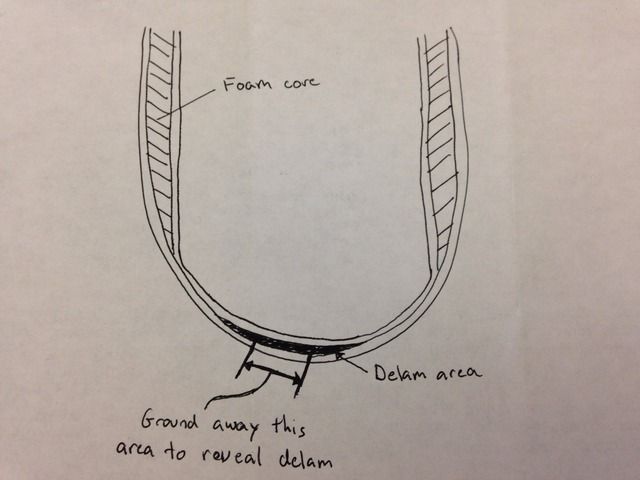I have an 84' H18 with cracks in bottom of hull from trailer rollers (replaced with bunks). The cracks arn't very long but they're completely through the out fiberglass skin.
My plan was to grind away outer cracked fiberglass to foam core and then lay down some new glass. As I ground away the outer layer of glass there was no foam core along center of hull. I did hit foam core about 4" from the center of hull, it was a parallel line running fore and aft.
Is there no foam core along center of hull from the factory?
84' Hobie 18 hull repair, no foam core along center of hull??

-
- Rank: Mate
- Registered: Sep 25, 2010
- Last visit: Oct 12, 2023
- Posts: 180
-
- Rank: Administrator
- Registered: Jul 19, 2001
- Last visit: Sep 07, 2025
- Posts: 3460
Bottom is solid fiberglass just like you found, with the core starting a little up from each side of center. The exact width of the solid glass "keel" probably varies quite a bit since they were hand laid up and the techniques changed over the years.
The 1984 models were the beginning of the "lightweight years" for the H18, generally 1984, 85, 86 were built light and were desired for a long time by H18 class racers. Unfortunately those are also the model years most likely to have a hull break off completely in front of the front beam. Watch for cracks and soft spots in that area and repair before they can get worse.
Check this topic for more info on the history of Hobie 18 construction.
http://www.thebeachcats.c…opic/topic/12598/start/0
--
Damon Linkous
1992 Hobie 18
Memphis, TN
Join the discussion at the all new TheBeachcats.com Forums HERE.
https://thebeachcats.temp…l.host/forums/site-talk/
-- -
- Rank: Mate
- Registered: Sep 25, 2010
- Last visit: Oct 12, 2023
- Posts: 180
There seems to be some serious delamination along center of hulls... the space I exposed extended at least 8" forward of where I was grinding. The hull should be completely solid between foam cores?
I checked and there's no cracking or soft spots around cross beams, or anywhere else for that matter. The hulls are in very good shape other than cracks from rollers. -
- Rank: Chief
- Registered: Nov 26, 2009
- Last visit: Sep 03, 2025
- Posts: 2532
On my 20' Mystere the foam started about 3-4" up from the centre of the keel.
This makes sense when you think about it.
The foam sections are covered with a very thin fiberglass layer. It is VERY easy to dent it. If the keels were foam, they would soon look like an axe murderer went at them.
It's all a compromise. For purely racing, you could save a bit of weight, however, the boat would be very delicate.
--
Hobie 18 Magnum
Dart 15
Mystere 6.0XL Sold Was a handful solo
Nacra 5.7
Nacra 5.0
Bombardier Invitation (Now officially DEAD)
Various other Dock cluttering WaterCrap
-- -
- Rank: Mate
- Registered: Mar 19, 2004
- Last visit: Sep 03, 2025
- Posts: 968
Pop open the access port behind the front crossbar. Take a flash light or shop light and shine it inside the hull and look down. You will see near the bottom of the hull, there is a step in the hull surface on both sides of the hull which runs forward and aft. This step is where the hull construction transitions from cored to solid laminate.
The hull should be completely solid everywhere. If it's soft on the bottoms, that means you have delamination between the glass layers and they would need to be ground out and built back up. If you don't repair, it's possible the hull roller could eventually punch up through the bottom of the hull (switching to cradles is a good idea too). The good news is that the front port hole should give you access to repair the boat from the inside as well as outside.
sm -
- Rank: Mate
- Registered: Sep 25, 2010
- Last visit: Oct 12, 2023
- Posts: 180
The hulls feel solid but there is definitely a clear seperation down center of hull for the two fiberglass layers that sandwich the core....
What would be best way to repair, cut away the glass on interior amd lay down new mat inside? Think I would be able to cut away glass with a razor knife? It feels very solid.... kind of scary going in there with a grinder and working blind.
What about drill and fill? I know it's not the proper way to repair but the two fiberglass layers are very firm inside and out.
Edited by car_guy on Jun 10, 2015 - 09:04 AM. -
- Rank: Mate
- Registered: Mar 19, 2004
- Last visit: Sep 03, 2025
- Posts: 968
Not clear where the damage exists. In your first post, you said that it was in the solid laminate section of the hull. Now you're saying you have delam between the outer skins and the core. Is the damage on the very bottom of the hull (the solid laminate section) or the hull sidewall (cored section)? Again, there is no foam core down the very center of the bottom of the hull, it is solid fiberglass. Look inside the hull about 3 to 4" up from the bottom you can see where the foam stops.
Pictures would help.
sm -
- Rank: Mate
- Registered: Sep 25, 2010
- Last visit: Oct 12, 2023
- Posts: 180
-
- Rank: Mate
- Registered: Mar 19, 2004
- Last visit: Sep 03, 2025
- Posts: 968
If it's delaminated, I would try to inject resin into the glass. It's going to be tricky because you'll have to be very careful as you drill into the hull so you don't punch through to the opposite side. Then use un-thickened resin and try to squirt it into the delaminated area and flex the hull as you do so to try to get the resin to work around inside the separated layers. If that doesn't work, I think you're gonna be grinding. It shouldn't be that bad if you have to grind it out though since it should be pretty obvious when you've gotten to solid glass.
sm -
- Rank: Mate
- Registered: Sep 25, 2010
- Last visit: Oct 12, 2023
- Posts: 180
I opened up the outer layer of the hull a little further and it looks like the gap between layers could be from the factory... is this possible? The gap is very uniform and there's evidence of excess resin "bridging" the gap between layers (pic 2), I don't see how this could happen if the gap was from delamination.
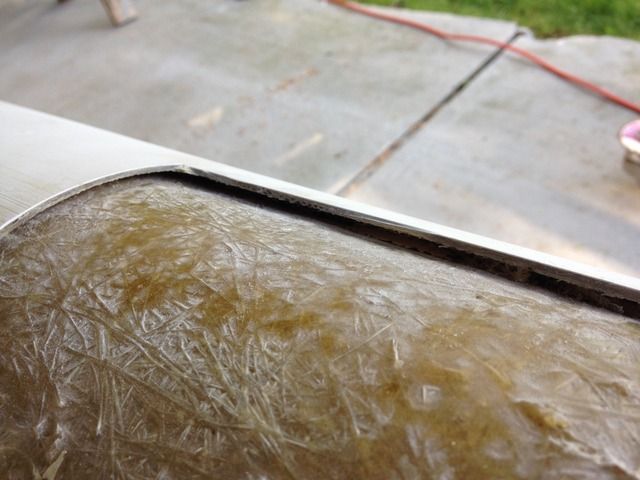
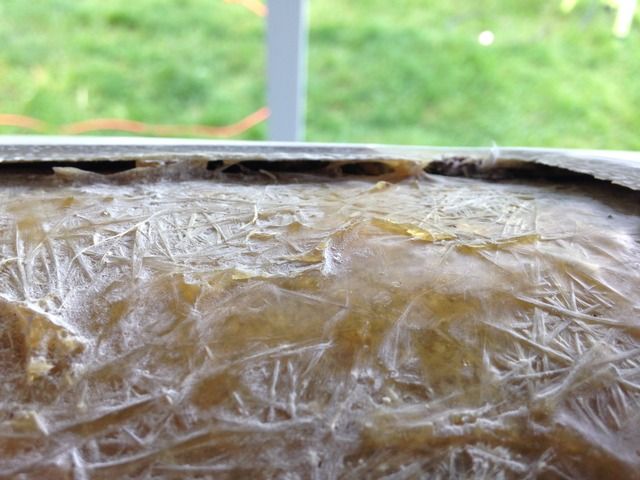
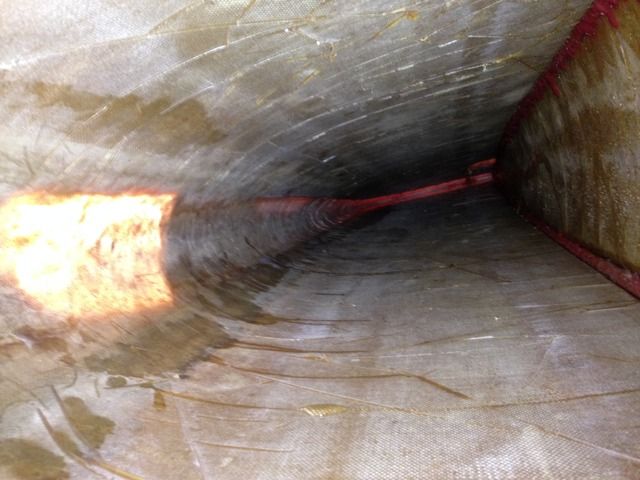
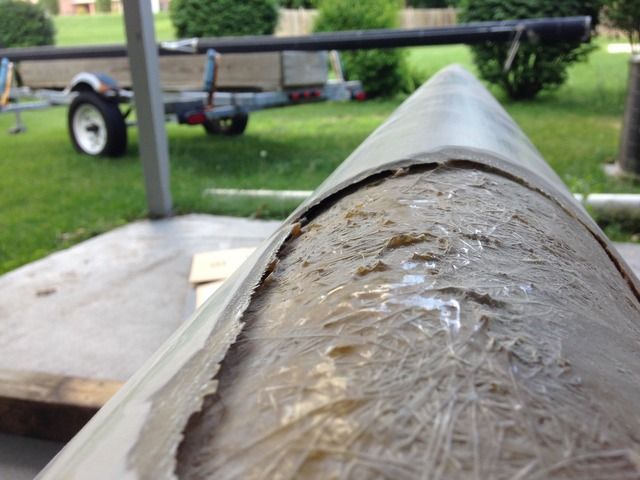
-
- Rank: Mate
- Registered: Mar 19, 2004
- Last visit: Sep 03, 2025
- Posts: 968
If I had to guess, I would say probable manufacturing defect. Boats built during this era were built in the early stages of Hobie's learning about vacuum bagging. My guess would be that they had an issue getting the inner skin to compress properly against the bottom of the boat - basically the inner layer of fiberglass bridged the inside radius creating a void between the glass layers. Either that or there was a really poor job done prepping the surface between layers of glass.
Anyway, it looks like what you've got there is a can of worms opened up. If it were me, I would probably take a quarter and rap the edge of it along the bottom of the hull. You should be able to hear a pitch difference between where you have good bond and bad bond (delamination). Mark out the delaminated area, carefully drill through until you hit the void, and then inject epoxy to bond the two layers back together.
If you continue down the path you're headed on, you could be in for a heck of a lot of fiberglass and gelcoat work.
sm -
- Rank: Mate
- Registered: Sep 25, 2010
- Last visit: Oct 12, 2023
- Posts: 180
I think a manufacturing defect is exactly what's going on here. Damn, I thought I picked up such a nice set of hulls too.... Definitely not grinding any further, drill and fill it is... Thanks -
- Rank: Administrator
- Registered: Jul 19, 2001
- Last visit: Sep 07, 2025
- Posts: 3460
That don't look good, never seen anything quite like it.
I think we've discovered why the 1984's were so light!
--
Damon Linkous
1992 Hobie 18
Memphis, TN
Join the discussion at the all new TheBeachcats.com Forums HERE.
https://thebeachcats.temp…l.host/forums/site-talk/
-- -
- Rank: Mate
- Registered: Sep 25, 2010
- Last visit: Oct 12, 2023
- Posts: 180
It's not going to be light anymore... lol.
Actually I did weight the 84' hulls when I first took the boat apart. They were 127lbs each which doesnt seem much lighter than other years... -
- Rank: Mate
- Registered: Mar 19, 2004
- Last visit: Sep 03, 2025
- Posts: 968
No it doesn't. My '85's are around 110-115LBS I believe. Is it a red line?
sm -
- Rank: Mate
- Registered: Sep 25, 2010
- Last visit: Oct 12, 2023
- Posts: 180




